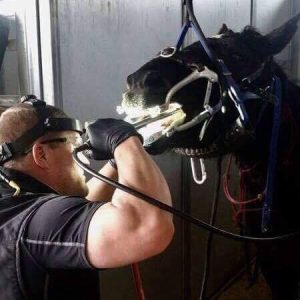
With almost 20 years of practice, working under various clinical and field environments, I can offer insight on how to set up a functioning work environment, including which equipment might work best for individual situations. The use of stocks and various modifications or add-ons can benefit a clinical setting. Mobile stocks or suspension bars attached to a receiver hitch on a vehicle can benefit with different types of field work.
Drop me an email or call/text me with questions. Depending on the type of consultation you are looking for, a consult fee may be required.
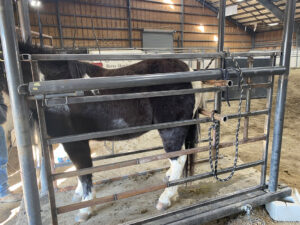
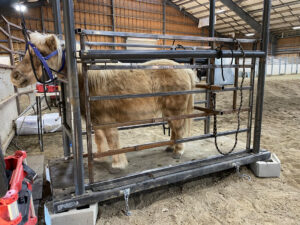
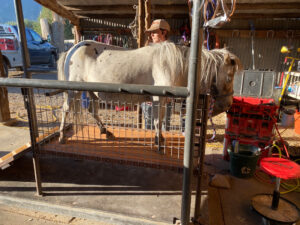
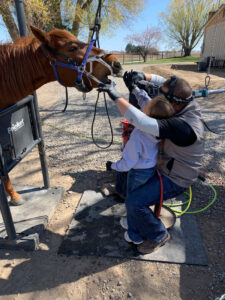

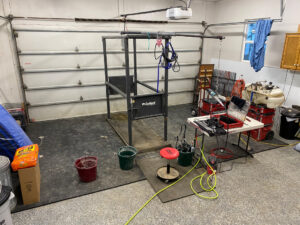
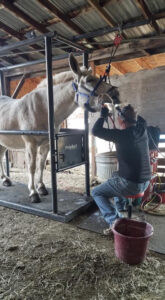
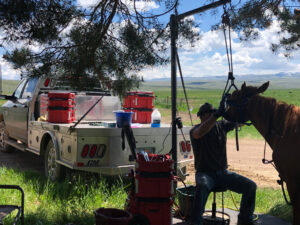

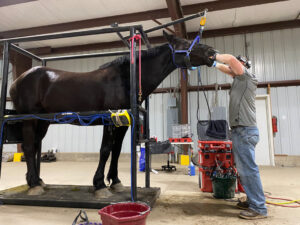

1. Use a suspension halter to perform precision dentistry.
There are various ways to hold a horse’s head while performing a dental procedure. Some practitioners use a dental stand or convince another person to balance the heavy head on their shoulder. Some practitioners will just move around with the horse. While one can perform dentistry procedures using these methods, a suspension halter is generally the best way to steady a horse head. The halter will not fall over or get fatigued. You don’t have to pay it to come to work every day. The horse can move slightly and it doesn’t need to be readjusted. If the horse decides to bolt over top of you, the halter provides some physical limits so the horse isn’t free to leave footprints across you body (yes, this happens and its a dental practitioner’s worst nightmare). If precision is a priority, a suspension halter is generally the least expensive and easiest method to stabilize a horse for dentistry and many oral surgeries.
2. Use dental stocks or chute when possible.
A dental stock puts a physical boundary around the horse that’s being worked on. It provides the practitioner with a barrier in case the horse startles and decides to push forward. It gives the horse side rails and a rear gate to lean on. While there are situations where a horse can try to jump out or kick the stocks, my experience is that it is better that the stocks take this punishment than the practitioner or whoever may be standing near. Stocks with an adjustable front gate and sides that open will allow the best flexibility for all sizes of horses as well as being able to extract a horse who gets himself into trouble while in the stocks. For small horses, I built metal panels that insert into my stocks that allow for an adjustable butt-bar. This. prevents small horses from escaping out the sides and the butt-bar keeps them pushed forward for them to be worked on. If you’ve worked on enough ponies, you’ll know that they are famous for attempting to pull backwards.
3. Use a digital charting system.
First of all, charting your work on every horse is vital. Whether you use a napkin, a blank paper, or a carbon-copy paper charting system, keeping records is an absolute necessity for any sustainable and successful equine dental practice. If you don’t chart your work ON EVERY HORSE, how can you know what you did the last time that horse was worked on? If another practitioner follows behind you, how will they know what you did? What if the mouth had already seen a practitioner and they left a total disaster? In this case, you need to make notes of what the mouth was before you started so the bad work doesn’t get blamed on you. I use a digital charting app called Pimbury. This is a cloud-based program that allows me to have a record of every horse. I can go back and look at the entire history of a particular horse. This program allows photos to be saved with the charts. It helps with billing and it sends the client an invoice and their charts if you choose. I no longer have to call my office and have a paper chart photographed and sent to me. All of my dental records are literally at the tip of my finger.
4. Use a very bright headlamp.
Yes, I sell headlamps and as much as I would prefer that you buy one AND a second as a backup, this isn’t necessarily a sales pitch for my product. When I was in my dental program, one of the instructors said, “we want a headlamp so bright that the light shines out the back if the horse lifts his tail”. Now, that was almost 2 decades ago and we did not have the super bright LED lighting that we have now. For practitioners who practice sight-dentistry or who will perform oral surgeries, a bright surgical light should illuminate the entire mouth. The light beam should have soft edges and not be a spot-style beam with a defined circle shape. The color of the light is very important as well. You want a white light, not one that has blue or yellow tint. This allows you to see the natural color of the tissues that you will be working on. A good surgical light will show all of the minor details that are necessary to note for proper and complete dental work.
5. Work with a clean mouth.
Precision dentistry cannot be performed with saliva and feed in the mouth. Period. Have the ability to fully rinse the mouth. During dental work, you should rinse the mouth several times. If you have to perform major tooth reductions, stopping to rinse the mouth periodically will keep the tooth and surrounding tissues cool. Rinsing the tooth debris from the mouth after you are finished likely makes the horse feel better. Your oral rinsing system should have the ability to rinse large quantities of water into the mouth as well as have a 90-degree, high pressure spout to rinse diastemas or extraction sites. When you are working and your instruments seem to get stuck as you push and pull them, it is likely due to the fact that the mouth tissues are dry. A quick shot of water will solve that problem. Using a bright light with a clean mouth, you’d be surprised at the things you will find and the details you will see.